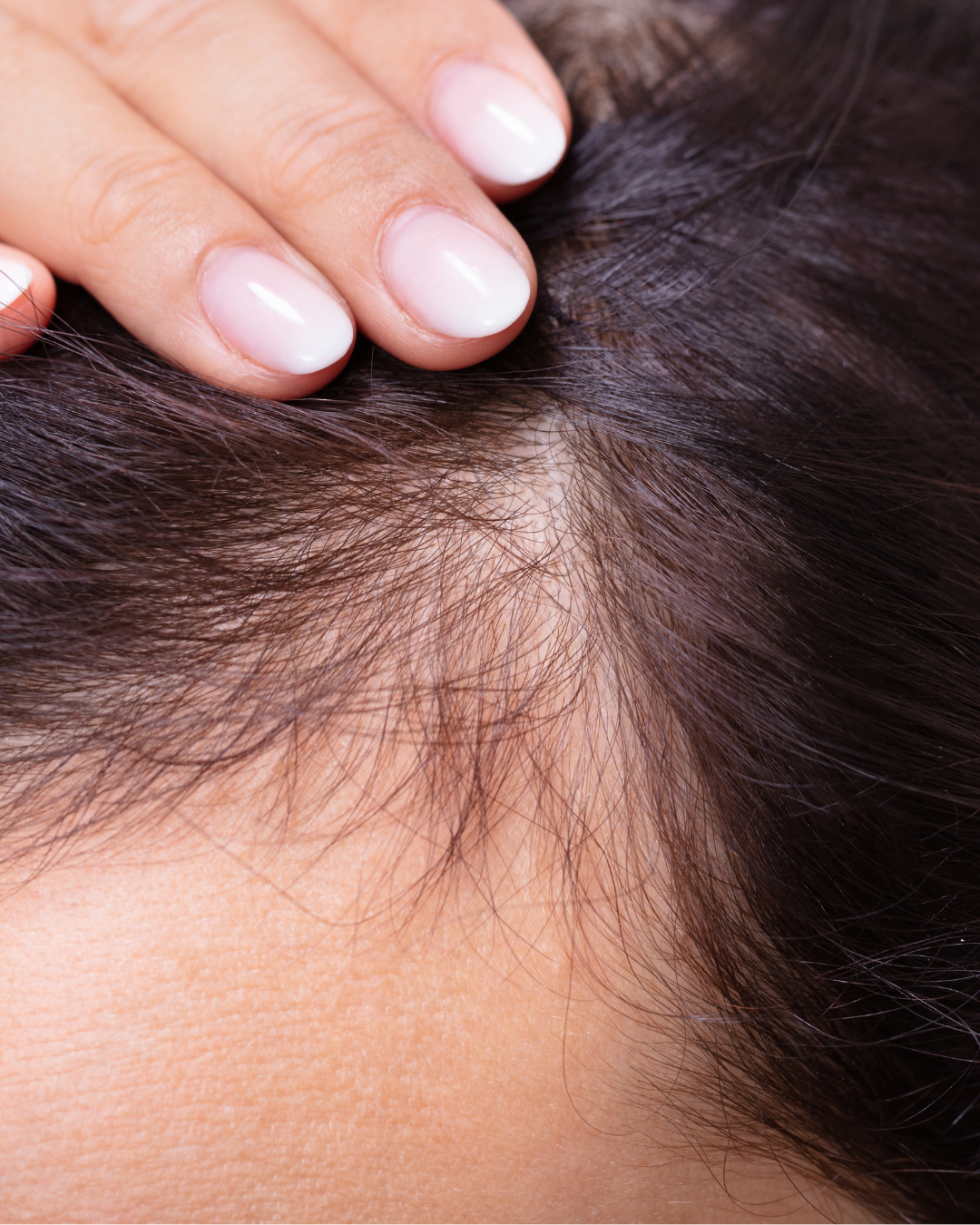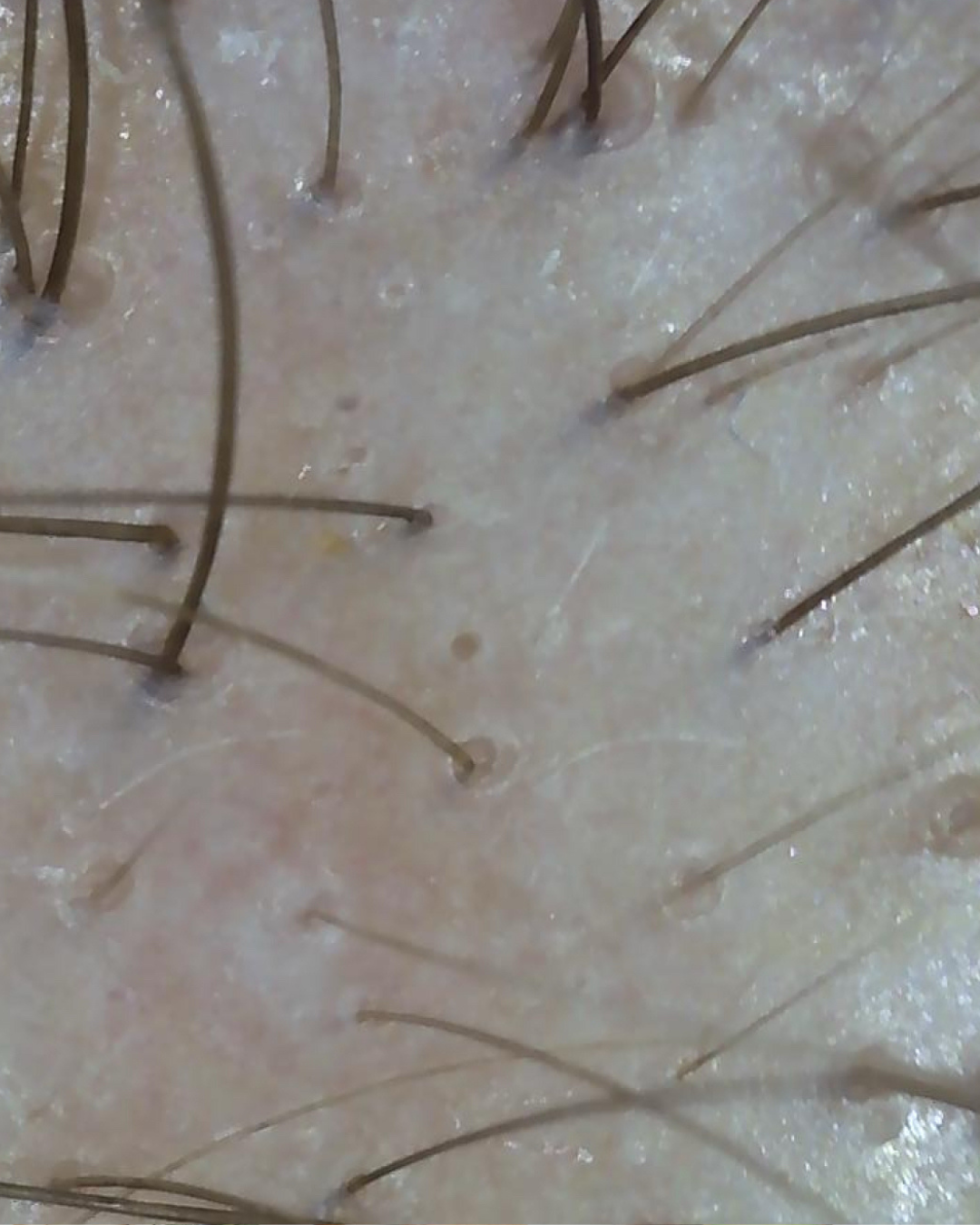Is My Hair Loss Permanent or Will It Grow Back?
Contents
You’re brushing your hair or tying it back when you notice something unsettling. Your ponytail feels smaller. There are more hairs in your brush. In the mirror, or worse, in a recent photo your parting looks wider than it used to.
At first, you tell yourself it’s nothing, but the worry grows. You start counting hairs in the shower, changing your hairstyle to hide thinning areas, scrolling late at night for answers.
Hair loss is more common than most people realise, but that doesn’t make it easier to live with. The good news? Not all hair loss is permanent, but without the right diagnosis, it’s almost impossible to know which type you have.
In this blog, I’ll explain how I assess whether hair loss is temporary or permanent, the most common causes of each, and why acting early can make a huge difference.
How Hair Grows and Why That Matters When You’re Shedding
Your scalp contains around 100,000 hair follicles, each cycling between growth, rest, and shedding. In a healthy scalp, you lose 50–100 hairs a day without noticeable thinning.
| Phase | What happens | Typical duration |
|---|---|---|
| Anagen | The active growth phase, where the follicle produces a healthy, fully formed hair strand. | 2–7 years |
| Catagen | A short transition phase where hair growth stops and the follicle begins to shrink. | 2–3 weeks |
| Telogen | The resting phase before the hair sheds naturally to make way for a new cycle. | ~3 months |
The difference between temporary and permanent hair loss isn’t just about the follicle, it’s about whether the cause can be corrected and whether the follicle structure remains intact. If the underlying trigger is removed and the follicle is still healthy, the hair cycle can restart. If the follicle has been permanently damaged or replaced with scar tissue, regrowth is not possible.
How Do I Know if My Hair Loss is Temporary or Permanent?
Temporary hair loss is often:
Diffuse (spread across the scalp)
Linked to a clear trigger think illness, surgery, childbirth, stress, dietary changes
Paired with a healthy-looking scalp
Followed by signs of regrowth, like short “baby” hairs around the hairline
Permanent hair loss often:
Develops gradually
Shows a specific pattern (widening parting in women, temple/crown thinning in men)
May include scalp changes in scarring conditions, shiny skin, redness, scaling
Many people have both at once — for example, genetic pattern loss made more obvious by Telogen Effluvium. And hair loss often starts 2–3 months after the trigger, making the cause less obvious without a professional eye.
Telogen Effluvium, The Most Common “Shock Loss”
Telogen Effluvium (TE) happens when more hairs than normal exit the growth phase at once. This is often triggered by a shock to the system, physical, emotional, or both.
Hair is the second fastest dividing cell in the body, making it highly sensitive to changes in your health. In TE, the proportion of hairs in the resting phase can jump from 10% to 30–50%, leading to sudden, noticeable shedding.
Common triggers include: illness, surgery, childbirth, medication changes, crash dieting, iron deficiency, low vitamin D, thyroid shifts, and prolonged stress.
Shedding usually starts 8–12 weeks after the trigger, which is why people often can’t connect the dots.
Acute Telogen Effluvium (ATE) tends to resolve within six months once the cause is treated. Chronic Telogen Effluvium (CTE) lasts longer and is usually linked to ongoing internal imbalances.
TE can overlay other conditions, for example, if you have genetic pattern loss, TE can make it look dramatically worse. Unless both are treated, you won’t get lasting results.
Will Hair Loss Due to Iron Deficiency Grow Back?
Iron deficiency is a major but often missed cause of hair shedding, particularly in women. Hair production is energy-intensive, if your iron stores are low, your body prioritises vital organs over hair growth.
With the right treatment, regrowth is possible, but only if the follicles are still healthy. The key is diagnosis, not guesswork. Many patients I see have spent months on generic hair vitamins without knowing their ferritin (stored iron) was low. Once corrected, shedding slows and regrowth becomes visible within months.
Iron deficiency often sits alongside other issues like low vitamin D, thyroid imbalances, or pattern hair loss, so unless all causes are addressed, you may only see partial improvement.
Hormonal Hair Loss — Can it be Reversed?
Hormonal shifts can have a powerful effect on the hair growth cycle. After pregnancy, many women experience postpartum shedding, which is a form of TE and usually resolves naturally within months.
During perimenopause and menopause, declining oestrogen can unmask an underlying genetic tendency to pattern thinning. Lower oestrogen levels also mean androgens (male hormones, present in both sexes) have a relatively greater influence, which can lead to miniaturisation in susceptible follicles.
Thyroid disorders — whether underactive or overactive — can also cause diffuse shedding and changes in hair texture
Whether hormonal hair loss can be reversed depends on the cause:
Postpartum TE – usually temporary and self-limiting.
Thyroid-related shedding – often reversible when the thyroid imbalance is corrected.
Menopausal shedding – may improve with a holistic plan addressing hormones, nutrition, scalp health, and any underlying pattern loss.
Androgenetic Alopecia — When Hair Loss Is Permanent
Androgenetic alopecia (AGA) also known as male pattern hair loss, female pattern hair loss, male pattern balding, or female pattern balding is the most common cause of permanent hair loss worldwide. This condition is genetic and strongly influenced by the hormone dihydrotestosterone (DHT).
DHT is formed when the enzyme 5α-reductase (5-alpha reductase) converts testosterone into a more potent androgen. In genetically susceptible individuals, DHT binds to receptors in certain scalp follicles, triggering a gradual shortening of the growth (anagen) phase and a process called miniaturisation.
Miniaturisation changes the hair over successive growth cycles:
The hair shaft becomes thinner in diameter
Each cycle produces a shorter hair than the last
Pigment fades, making hairs appear lighter and less visible
Eventually, the follicle produces only a fine vellus-like hair or stops producing hair altogether
Patterns of loss vary:
In women, AGA usually appears as a widening central parting and diffuse thinning across the top of the scalp, with the frontal hairline often preserved until later stages.
In men, it often begins with temporal recession and thinning at the crown, which may progress to more advanced baldness if untreated.
Once a follicle has miniaturised to the point of producing only vellus hairs, or has been inactive for a prolonged period it becomes unlikely to recover. In these cases, regrowth is not possible.
Early diagnosis and intervention are crucial. Acting before extensive miniaturisation allows for:
Preservation of existing terminal hairs
Thickening of partially miniaturised hairs
Slowing or halting further progression
Because AGA is a progressive condition, waiting until thinning is visible to others often means significant follicle changes have already occurred. If you’re concerned about gradual hair loss that matches these patterns, a professional scalp assessment can confirm the diagnosis and outline treatment options before more hair is lost.
Scarring Alopecias — Why Time is Critical
Scarring alopecias, also called cicatricial alopecias, are a group of inflammatory conditions where the hair follicle is irreversibly destroyed and replaced with scar tissue. Unlike non-scarring hair loss, once the follicle is lost in these cases, regrowth is not possible.
Common types include:
Lichen planopilaris (LPP)
Frontal fibrosing alopecia (FFA)
Central centrifugal cicatricial alopecia (CCCA)
Discoid lupus erythematosus (DLE)
Early signs may be subtle, such as:
Redness or inflammation around hair follicles (perifollicular erythema)
Scaling or flaking around the follicle opening
Burning, tenderness, or itching of the scalp
Patches where the skin appears shiny and the normal follicle openings are absent
In later stages, these areas may expand and blend, leading to visible thinning or complete bald patches that do not regrow.
The exact cause varies, some are linked to autoimmune reactions, others to chronic inflammation, or a combination of both. While the permanent damage cannot be reversed, early diagnosis is critical because medical treatment can often:
Reduce inflammation
Prevent further follicle destruction
Stabilise the condition before it spreads
Multifactorial Hair Loss — When More Than One Condition is at Play
Not all hair loss can be traced back to a single cause. In many cases, two or more conditions occur simultaneously, creating a more complex picture. This is known as multifactorial hair loss or coexisting hair loss conditions.
Examples include:
Female pattern hair loss made more noticeable by telogen effluvium after illness or surgery
Menopausal pattern thinning compounded by iron deficiency or low vitamin D
Scarring alopecia occurring alongside a nutritional deficiency
Male pattern hair loss accelerated by rapid weight loss and stress
When multiple types of hair loss occur together, they can intensify overall shedding and make the condition appear to progress more quickly. If only one cause is identified and treated, results may be limited or temporary.
A thorough assessment looks beyond the visible thinning. It considers scalp health, hormonal status, nutritional profile, and lifestyle factors to build a complete picture. By identifying and addressing all contributing factors, treatment can be tailored to slow, stop, and where possible, reverse certain types of loss.
Why Early Diagnosis is Your Best Chance for Regrowth
Hair loss is far easier to manage, and in many cases, improve, when it’s caught early. The sooner you identify the underlying cause, the more options you have to preserve existing hair and encourage regrowth.
In the early stages of hair loss:
Follicles are still active and capable of producing strong hairs
Miniaturised hairs can often be thickened back to terminal hairs
Triggers such as nutrient deficiencies, hormonal imbalances, or inflammatory scalp conditions can be addressed before permanent damage occurs
Waiting until hair loss is clearly visible to others often means significant follicle changes have already taken place. In permanent conditions such as androgenetic alopecia or scarring alopecias, this can limit how much improvement is achievable.
Even in temporary conditions like telogen effluvium, a delayed diagnosis can allow the trigger to persist for months, prolonging shedding unnecessarily.
Early intervention doesn’t just protect your hair, it can also give you peace of mind. Knowing exactly what’s happening (and why) helps you focus on a targeted treatment plan rather than guessing, worrying, or wasting money on products that may not address the real cause.
Concerned About Your Hair Loss? Let’s Find Out What’s Possible
If you’ve noticed more hair shedding than usual, a thinner ponytail, a widening parting, a receding hairline or more visible crown you don’t have to keep wondering whether it’s temporary or permanent.
During a consultation, I’ll look beyond just your scalp. I’ll assess your medical history, lifestyle factors, and, where needed, recommend specific investigations to identify all the contributing causes. This isn’t about guesswork, it’s about building a clear, evidence-based picture of what’s happening and creating a treatment plan that works for you.
Whether your hair loss is reversible, permanent, or multifactorial, there are always steps we can take to protect the hair you have and, in many cases, improve what’s growing.
You don’t need to figure this out alone, and the sooner we start, the more we can protect.
Book your consultation today and take the first step towards clarity, confidence, and a plan tailored to your needs.














